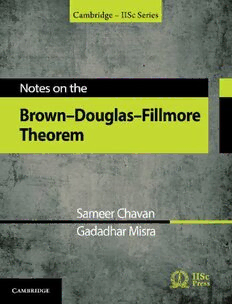
Notes on the Brown-Douglas-Fillmore Theorem (Cambridge IISc Series) PDF
Preview Notes on the Brown-Douglas-Fillmore Theorem (Cambridge IISc Series)
(cid:105) (cid:105) “BDFT˙Book” — 2021/5/18 — 12:14 — page i — #1 (cid:105) (cid:105) Notes on the Brown–Douglas–Fillmore Theorem The Brown–Douglas–Fillmore (BDF) theorem provides a remarkable solution to a long-standing open question in operator theory. The solution is obtained by first finding an equivalent formulation of the problem involving extensions of C∗-algebras. This does not make the original problem any simpler. None the less, Brown, Douglas, and Fillmore used newtoolsfromalgebraictopologyandhomologicalalgebratosolvetheproblemofextensions of commutative C∗-algebras. This new approach also inspired the study of extensions of non-commutativeC∗-algebras. ThespurtofactivityaroundtheBDFtheoremintheseventies wastheprecursortotheimportantfieldsofnon-commutativegeometryandK-theory. The book presents the original proof of BDF in its entirety. Some parts of this proof, which were only briefly indicated in the BDF paper “Unitary equivalence modulo the compact operatorsandextensionsofC*-algebras”publishedintheSpringerLectureNotes345,appear here in complete detail. These notes have attempted to preserve the crucial connection of the BDF theorem with concrete problems in operator theory. This connection, for instance, is manifestinthestudyoftheArevson–Douglasconjecture. Sameer Chavan is Professor in the Department of Mathematics and Statistics at the Indian InstituteofTechnology,Kanpur. Hispublicationsinsingle-andmulti-variableoperatortheory useavarietyoftoolsfromgraphtheoryandclassicalanalysis. HeisanAssociateEditorofthe IndianJournalofPureandAppliedMathematicssince2020. Gadadhar Misra is Professor in the Department of Mathematics at the Indian Institute of Science, Bangalore. His research in operator theory is mainly focused on operators in the Cowen–Douglasclassandthestudyofhomogeneousoperators. HehasbeentheEditorofthe ProceedingsofMathematicalSciencesduringtheperiod2005–2012andoftheIndianJournal ofPureandAppliedMathematicsduringtheperiod2015–2020. (cid:105) (cid:105) (cid:105) (cid:105) (cid:105) (cid:105) “BDFT˙Book” — 2021/5/18 — 12:14 — page ii — #2 (cid:105) (cid:105) CAMBRIDGE–IIScSERIES Cambridge–IIScSeriesaimstopublishthebestresearchandscholarlyworkindifferentareas ofscienceandtechnologywithemphasisoncutting-edgeresearch. The books aim at a wide audience including students, researchers, academicians and professionalsandarebeingpublishedunderthreecategories: researchmonographs,centenary lecturesandlecturenotes. The editorial board has been constituted with experts from a range of disciplines in diverse fieldsofengineering,scienceandtechnologyfromtheIndianInstituteofScience,Bangalore. IIScPressEditorialBoard: AmareshChakrabarti,Professor,CentreforProductDesignandManufacturing DiptimanSen,Professor,CentreforHighEnergyPhysics PrabalKumarMaiti,Professor,DepartmentofPhysics S.P.Arun,AssociateProfessor,CentreforNeuroscience Titlesinprintinthisseries: • ContinuumMechanics: FoundationsandApplicationsofMechanicsbyC.S.Jog • FluidMechanics: FoundationsandApplicationsofMechanicsbyC.S.Jog • NoncommutativeMathematicsforQuantumSystemsbyUweFranzandAdamSkalski • Mechanics,WavesandThermodynamicsbySudhirRanjanJain • FiniteElements: TheoryandAlgorithmsbySashikumaarGanesanandLutzTobiska • Ordinary Differential Equations: Principles and Applications by A. K. Nandakumaran, P.S.DattiandRajuK.George • LecturesonvonNeumannAlgebras,2ndEditionbySerbanValentinSt˘rati˘laandLa´szlo´ Zsido´ • Biomaterials Science and Tissue Engineering: Principles and Methods by Bikramjit Basu • KnowledgeDrivenDevelopment: BridgingWaterfallandAgileMethodologiesbyManoj KumarLal • Partial Differential Equations: Classical Theory with a Modern Touch by A. K. NandakumaranandP.S.Datti • ModularTheoryinOperatorAlgebras,2ndEditionbyS¸erbanValentinStra˘tila˘ (cid:105) (cid:105) (cid:105) (cid:105) (cid:105) (cid:105) “BDFT˙Book” — 2021/5/18 — 12:14 — page iii — #3 (cid:105) (cid:105) Cambridge–IISc Series Notes on the Brown–Douglas–Fillmore Theorem Sameer Chavan Gadadhar Misra (cid:105) (cid:105) (cid:105) (cid:105) (cid:105) (cid:105) “Imprints” — 2021/5/18 — 12:40 — page i — #1 (cid:105) (cid:105) UniversityPrintingHouse,CambridgeCB28BS,UnitedKingdom OneLibertyPlaza,20thFloor,NewYork,NY10006,USA 477WilliamstownRoad,PortMelbourne,VIC3207,Australia 314to321,3rdFloor,PlotNo.3,SplendorForum,JasolaDistrictCentre,NewDelhi110025,India 103PenangRoad,#05–06/07,VisioncrestCommercial,Singapore238467 CambridgeUniversityPressispartoftheUniversityofCambridge. ItfurtherstheUniversity’smissionbydisseminatingknowledgeinthepursuitof education,learningandresearchatthehighestinternationallevelsofexcellence. www.cambridge.org Informationonthistitle: www.cambridge.org/9781316519301 © SameerChavanandGadadharMisra2021 Thispublicationisincopyright. Subjecttostatutoryexception andtotheprovisionsofrelevantcollectivelicensingagreements, noreproductionofanypartmaytakeplacewithoutthewritten permissionofCambridgeUniversityPress. Firstpublished2021 PrintedinIndia AcataloguerecordforthispublicationisavailablefromtheBritishLibrary LibraryofCongressCataloging-in-PublicationData Names: Chavan,Sameer,author. |Misra,Gadadhar,author. Title: NotesontheBrown-Douglas-Fillmoretheorem/SameerChavan, GadadharMisra. Description: Cambridge;NewYork,NY:CambridgeUniversityPress,2021. | Series: Cambridge-IIScseries|Includesbibliographicalreferencesand index. Identifiers: LCCN2021013072(print)|LCCN2021013073(ebook)|ISBN 9781316519301(hardback)|ISBN9781009023306(ebook) Subjects: LCSH:Operatortheory. |C*-algebras. |Topologicalalgebras. | BISAC:MATHEMATICS/General Classification: LCCQA329.C432021(print)|LCCQA329(ebook)|DDC 515/.724–dc23 LCrecordavailableathttps://lccn.loc.gov/2021013072 LCebookrecordavailableathttps://lccn.loc.gov/2021013073 ISBN978-1-316-51930-1Hardback CambridgeUniversityPresshasnoresponsibilityforthepersistenceoraccuracy ofURLsforexternalorthird-partyinternetwebsitesreferredtointhispublication, anddoesnotguaranteethatanycontentonsuchwebsitesis,orwillremain, accurateorappropriate. (cid:105) (cid:105) (cid:105) (cid:105) (cid:105) (cid:105) “BDFT˙Book” — 2021/5/18 — 12:14 — page v — #5 (cid:105) (cid:105) TothememoryofR.G.Douglaswithgreatadmiration, muchaffectionanddeeprespect. ThesecondnamedauthorisgratefultoR.G.Douglasforthemathematical traininghehasreceivedfromhim,firstasadoctoralstudentandthenwhile workingtogetheronseveraljointresearchprojects. (cid:105) (cid:105) (cid:105) (cid:105) (cid:105) (cid:105) “BDFT˙Book” — 2021/5/18 — 12:14 — page vi — #6 (cid:105) (cid:105) (cid:105) (cid:105) (cid:105) (cid:105) (cid:105) (cid:105) “BDFT˙Book” — 2021/5/18 — 12:14 — page vii — #7 (cid:105) (cid:105) Contents Preface ix Overview 3 1 SpectralTheoryforHilbertSpaceOperators 7 1.1 PartialIsometriesandPolarDecomposition 7 1.2 CompactandFredholmOperators 9 1.3 FredholmIndexandAbstractIndex 19 1.4 SchattenClasses 34 1.5 IsometriesandvonNeumann–WoldDecomposition 37 1.6 ToeplitzOperatorswithContinuousSymbols 43 1.7 NotesandExercises 47 2 Ext(X)asaSemigroupwithIdentity 57 2.1 EssentiallyNormalOperators 57 2.2 Weyl–vonNeumann–Berg–SikoniaTheorem 60 2.3 ExtensionsandEssentiallyUnitaryOperators 66 2.4 AbsorptionLemma 70 2.5 WeaklyandStronglyEquivalentExtensions 73 2.6 ExistenceandUniquenessofTrivialClass 76 2.7 IdentityElementforExt(X) 82 2.8 NotesandExercises 86 3 SplittingandtheMayer–VietorisSequence 91 3.1 Splitting 91 3.2 DisjointSumofExtensions 94 3.3 FirstSplittingLemma 97 3.4 Surjectivityof(i ) 100 A,X ∗ 3.5 Ext(A)→Ext(X)→Ext(X/A)isExact 108 3.6 Mayer–VietorisSequence 112 3.7 NotesandExercises 114 (cid:105) (cid:105) (cid:105) (cid:105) (cid:105) (cid:105) “BDFT˙Book” — 2021/5/18 — 12:14 — page viii — #8 (cid:105) (cid:105) viii Contents 4 DeterminationofExt(X)asaGroupforPlanarSets 117 4.1 SecondSplittingLemma 117 4.2 ProjectiveLimitsandIteratedSplittingLemma 124 4.3 Ext(X)isaGroup 130 4.4 γ isInjective 133 X 4.5 BDFTheoremandItsConsequences 140 4.6 NotesandExercises 144 5 ApplicationstoOperatorTheory 147 5.1 BergmanOperatorsandSurjectivityofγ 147 X 5.2 HyponormalOperatorsandm-Isometries 152 5.3 EssentiallyNormalCircularOperators 157 5.4 EssentiallyHomogeneousOperators 159 5.5 EssentiallyReductiveQuotientandSubmodules 164 5.6 NotesandExercises 175 Epilogue 179 • OtherProofs 179 ◦ PropertiesofExt(X) 180 ◦ Theshortexactsequence 180 ◦ Arveson’sproofof“Ext(X)isagroup” 181 • RelatedDevelopments 182 ◦ Ext(A,B) 182 ◦ Homotopyinvariance 183 ◦ K-theory 185 • OpenProblems 187 ◦ Essentiallynormaltuples 187 ◦ Essentiallyhomogeneoustuples 189 ◦ Arveson–Douglasconjecture 190 AppendixA PointSetTopology 193 AppendixB LinearAnalysis 201 AppendixC TheSpectralTheorem 217 References 233 SubjectIndex 241 IndexofSymbols 245 (cid:105) (cid:105) (cid:105) (cid:105)
